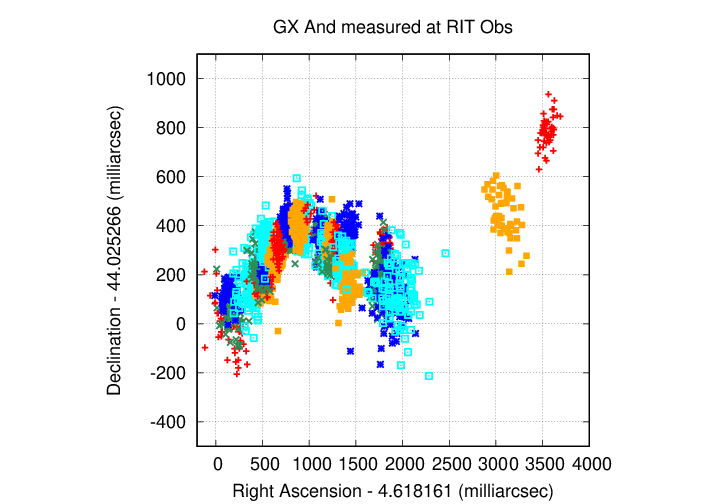
On the night of Aug 14/15, 2021, under good conditions, I acquired images of
One can find information about V627 Peg at
No problems, some good measurements, though the star is growing pretty faint for my setup.
I installed the new ATIK EFW-2 filterwheel, with the same old filter set. It works nicely. Good!
Christian Knigge is soliciting observations of this cataclysmic variable star at all wavelengths. The AAVSO has advertised for optical measurements, and I'm joining the effort.
The main setup was:
Notes from the night:
The object is located at
RA = 21:38:06.63 Dec = +26:19:56.0 (J2000)
A chart of the field is shown below. The size of the chart is about 31 x 26 arcminutes.

I've marked the location of several comparison stars as well. See
I'll use star "D" to shift my instrumental magnitudes to the V-band scale. It has a V-band magnitude (according to AAVSO chart X26768AQ) of 12.002, and (B-V) = 0.692.
The star marked "X" is an eclipsing binary of type EW, with a period of 0.36 days and amplitude of about +/- 0.3 mag in V-band.
I took a photo of the finder TV's screen when pointing to this target; this could be a useful reference for the future:

The sky value shows light clouds early, then clear.

The FWHM graph below shows a small amount of drift. I refocused near the end of this run.

Using aperture photometry with a radius of 7 pixels in a V filter (binned 2x2, each pixel is 1.24 arcsec, so a radius of 8.7 arcsec), I measured the instrumental magnitudes of a number of reference stars and the target. Following the procedures outlined by Kent Honeycutt's article on inhomogeneous ensemble photometry, I used all stars available in each image to define a reference frame, and measured each star against this frame.
Sigma-vs-mag plots show that the floor was about 0.007 mag; I removed one outlier.

The change in zeropoint shows only a few outliers.

Here is the light curve of the object and several field stars in the V filter; I've shifted the instrumental magnitudes so that star "D" = 000-BJV-433 on AAVSO chart X26767AK has the value given by AAVSO as its V-band magnitude.

Here's a closeup, also showing the light curve of star "X", the EW variable just south of the target.

I have submitted these measurements to the AAVSO, CBA, and VSNet.
You can download my measurements below. A copy of the header of the file is shown to explain the format.
# Measurements of V627Peg made at RIT Obs, UT 2021 Aug 15, # in good conditions, # by Michael Richmond, # using Meade 12-inch LX200 and ATIK 11000. # Exposures 90 seconds long, V filter. # Tabulated times are midexposure (FITS header time - half exposure length) # and accurate only to +/- 1 second (??). # 'mag' is a differential magnitude based on ensemble photometry # using a circular aperture of radius 7 pix = 8.8 arcseconds. # which has been shifted so AAVSO 000-BJV-433 has mag=12.002 # which is its V-band magnitude according to AAVSO chart X26767AK. # # UT_day JD HJD mag uncert Aug15.11698 2459441.61698 2459441.62143 14.416 0.038 Aug15.11818 2459441.61818 2459441.62263 14.475 0.037 Aug15.11939 2459441.61939 2459441.62384 14.439 0.037
This is one of the stars that a capstone student may study over the next year in a project involving parallax. Ross 248 is a relatively faint red star surrounded by many other stars of similar brightness, so it's a good candidate for high-precision parallax measurements.
These observations involved:
The object is (currently) near position
RA = 23:41:55.27 Dec = +44:10:06.38 (J2000)
A chart of the field is shown below. The size of the chart is about 41 x 27 arcminutes. The noisy area at right (West) is the shadow of the guider's pickoff mirror.

I've marked the location of several comparison stars.
star UCAC4 B V r ------------------------------------------------------------------------- A UCAC4 671-120730 12.617 10.689 B UCAC4 671-120688 C UCAC4 671-120749 10.987 10.663 P kappa And 4.06 4.14 --------------------------------------------------------------------------
I took a photo of the finder TV's screen when pointing to Ross 248; this could be a useful reference for the future:

Here are the positions I've measured so far. The most recent measurements are at bottom right.

Like Ross 248, GX And is a nearby (binary) star which will be the target of a parallax project in the coming year. One of the two components is bright -- about mag V = 8 -- so one must use short exposures to prevent it from saturating the detector. That may mean that this system isn't as easy to measure as Ross 248 or some others.
The object is currently close to this position:
RA = 00:18:28.4 Dec = +44:01:31 (J2000)
but it does have a very high proper motion.
A chart of the field is shown below. The size of the chart is about 41 x 27 arcminutes. The noisy area at right (West) is the shadow of the guider's pickoff mirror.

The two components of the GX And binary sit inside the box. I've marked the location of several comparison stars as well.
star UCAC4 B V r ----------------------------------------------------------- A 671-001473 9.939 9.790 B 670-001639 9.413 8.472 C 671-001509 12.712 11.421 11.001 -----------------------------------------------------------
I took a photo of the finder TV's screen when pointing to GX And; this could be a useful reference for the future:

Using the same techniques as described for earlier nights, I matched detected stellar positions to the Gaia DR2 catalog.
The target is moving to the upper-right with time, and clearly shows the back-and-forth motion due to parallax.

Last modified 8/15/2021 by MWR.